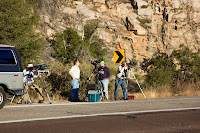 |
| Click to enlarge |
I had planned to take an image every ten seconds and then make a time lapse- I set up a tracking mount along with my Stellarvue 90mm triplet refractor, a Lunt Herschel Prism, and my Canon T2i with a 2x Barlow lens. As the Sun dipped toward the horizon I made sure everything was set- and sadly, I forgot to turn off the tracking! So instead of the telescope remaining fixed on the summit observatories, it continued to track on the sun as the observatories slowly drifted up out of the field of view! Regardless I ended up with a few nice images which I present here. As you can see we had a large number of clouds drifting through and it made for some very photogenic moments.
First up, are two images of the Sun as it was descending behind Kitt Peak. As always, click them to enlarge to full size and if your browse automatically resizes images, you may need to click them again.
Next, I was delighted to discover when going through my pictures that I captured the Green Rim! Many have heard of the elusive "Green Flash" which is actually a distortion of the Sun's green rim. The short explanation for this is that our atmosphere acts similarly to a prism as the Sunlight moves through it toward us, and the suns light is refracted and spreads out much like in a rainbow. While you may expect the rim to be blue, similar to the rainbow, our atmosphere scatters much of the blue light and we are left with the upper limb of the Sun appearing greenish. When most of the Sun is below the horizon and it is no longer overwhelmingly bright, we can often see this green rim with the magnification supplied by binoculars or a telescope.
Finally, once I pulled the camera from the telescope, I put a 24-105 zoom lens on with a polarizing filter and took the image below at the 105mm setting. It was 1/500 of a second at f/4.
This was so fun, I may try again on the 24th. In case you are wondering how we could have a second opportunity to find the Sun setting in the same place on the horizon within a week...we are approaching the winter solstice in approximately 3 days. At solstice, the Sun reaches its most southerly point in our sky and then begins its trek northward...so about 3 days after solstice it will again be setting behind KPNO.




Wonderful images, Alan!
ReplyDeleteThanks! Dean, Melinda and I were actually talking about you while we were there saying how much we missed your enthusiasm for observing! Happy holidays to you, Nicole and the family!
ReplyDelete